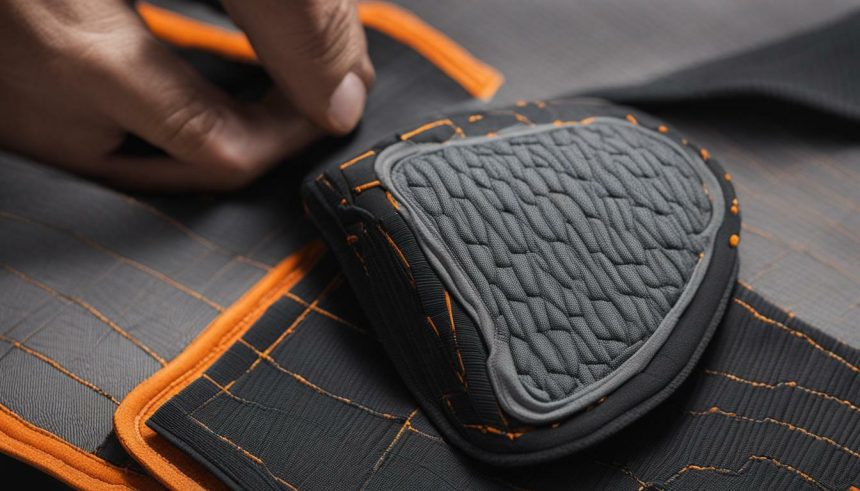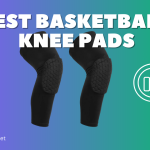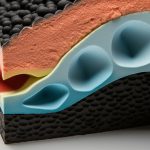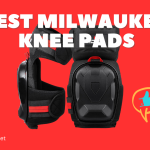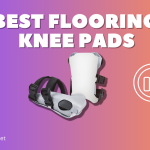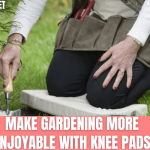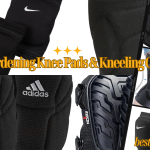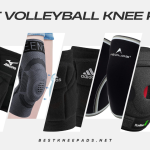Knee pads are essential protective gear for anyone engaging in activities that put pressure on the knees, such as sports, construction work, and gardening. The materials used to make knee pads play a critical role in determining their effectiveness in providing protection and comfort.
In this section, we will discuss the different materials used to make knee pads, from traditional foam and fabric to advanced options like neoprene and gel. We will also explore the characteristics and benefits of impact-resistant shells and breathable fabrics that enhance the performance of knee pads.
Key Takeaways
- Knee pads are made of various materials, including foam, rubber, fabric, neoprene, gel, and more.
- Impact-resistant shells provide an extra layer of protection against impacts and abrasions.
- Breathable fabrics, such as mesh or moisture-wicking materials, promote ventilation and manage moisture build-up for greater comfort.
- Specialized knee pad materials, like Kevlar and silicone, are designed for specific activities.
- Understanding the materials used in knee pads is vital for selecting the right pair for your needs.
Traditional Materials Used in Knee Pads
When it comes to knee pads, traditional materials have been the go-to for providing protection to the knees. Foam, rubber, and fabric are the most commonly used materials in knee pads due to their ability to offer a balance of comfort, flexibility, and impact resistance.
Foam: The foam used in knee pads is typically closed-cell foam, which is a denser and more durable form of foam. This type of foam is known for its shock-absorbing properties, which help to disperse the impact of a fall or collision evenly. Closed-cell foam is also resistant to water and other liquids, ensuring that it doesn’t get weighed down or lose its protective qualities.
Rubber: Rubber is another material commonly used in knee pads due to its flexibility and durability. Rubber knee pads provide a secure, non-slip fit that helps to keep them in place during physical activity. The material is also highly resistant to abrasions and cuts, which makes it ideal for use in rough environments.
Fabric: The fabric used in knee pads is typically a blend of breathable and durable fibers, like polyester or nylon. This material is used to cover the padding of the knee pad and is responsible for providing both comfort and protection. The fabric allows for ventilation and helps to wick away moisture, which helps to keep the wearer cool and dry during physical activity.
Traditional Materials Used in Knee Pads
In addition to foam, rubber, and fabric, other traditional materials like leather and plastic have been used in knee pads. Leather provides a natural and comfortable fit, while plastic is highly durable and impact-resistant. However, these materials are less commonly used in knee pads today than they were in the past.
Understanding the traditional materials used in knee pads can help you make an informed decision when choosing the right pair for your needs. Each material offers its own set of benefits, from shock absorption to flexibility to durability. By evaluating the features you need most in a knee pad, you can select the material that will provide you with the best protection possible.
Advanced Materials for Enhanced Knee Protection
As we mentioned earlier, advancements in technology have led to the development of more advanced materials for knee pads. These materials provide superior protection, durability, and stability, compared to traditional options.
Neoprene
Neoprene is a synthetic rubber material that is commonly used in knee pads. It is known for its excellent durability, resistance to abrasions, and ability to retain its shape over time. Neoprene knee pads offer excellent support and stability while remaining comfortable and flexible. This makes them an ideal choice for high-intensity activities that require intense knee movements.
Gel
Gel is another advanced material that is used in knee pads. It provides superior impact resistance, helping to reduce the risk of injury from falls or collisions. Gel knee pads are typically made with a layer of gel that is integrated into the padding material, creating a cushioning effect that helps to distribute weight evenly across the knee. This reduces pressure points and enhances overall comfort.
Memory Foam
Memory foam is a viscoelastic material that is commonly used in mattresses and pillows. It is also used in knee pads due to its ability to conform to the shape of the knee, creating a custom fit that offers superior support and stability. Memory foam knee pads are designed to retain their shape over time, ensuring that they provide consistent protection, even after extended use. They are also known for their excellent shock absorption properties, making them an ideal choice for activities that involve sudden movements or impacts.
Overall, the use of advanced materials in knee pads has revolutionized the way we protect our knees during physical activities. Neoprene, gel, and memory foam are just a few examples of the many options available, each with their own unique benefits and characteristics. By taking the time to understand these materials, you can choose a knee pad that offers the level of protection, support, and comfort that you need
Impact-Resistant Shells for Maximum Defense
Along with the padding materials, knee pads often incorporate impact-resistant shells to provide an extra layer of protection against impacts and abrasions. These shells are typically made of hard plastics or thermoplastic materials.
These materials enhance the overall performance of knee pads by providing maximum defense against heavy impacts. The hard outer shell prevents injuries by distributing the force of the impact or collision over a larger surface area, reducing the impact on any one point. This feature can be particularly beneficial in high-impact sports like basketball or volleyball, where players are at increased risk of knee injuries due to sudden stops and jumps.
Impact-resistant shells also provide an additional advantage in outdoor activities like skateboarding and BMX biking. The shells guard against abrasions from falls or scrapes on rough surfaces, such as concrete or asphalt.
Choosing the Right Shell Material
When selecting knee pads with impact-resistant shells, it is essential to consider the materials used. Hard thermoplastic materials and hard plastic shells provide excellent protection, but they may not be the most comfortable option for extended use due to their inflexibility. Softer materials such as foam may be more comfortable but do not offer the same level of protection against impacts and abrasions.
Ultimately, the choice of shell material boils down to personal preference and intended use. If you require ultimate protection, it is best to opt for a harder material like thermoplastic. If comfort is a top priority, a softer shell material may be a better choice.
Breathable Fabrics for Comfort and Moisture Management
At the core of our knee pad materials, we understand the importance of comfort during extended periods of use. That’s why we incorporate breathable fabrics into many of our knee pads. These fabrics promote ventilation and manage moisture build-up, enhancing the overall comfort of the wearer.
Mesh is a popular choice for breathable knee pad fabrics. Its open structure allows for increased airflow, reducing heat build-up around the knees. The result is a cooler, more comfortable feel during use.
In addition to mesh, many knee pads feature moisture-wicking materials. These fabrics help to keep the knees dry by moving sweat away from the body. This helps to prevent skin irritation and chafing, allowing for longer sessions of activity without discomfort.
Whether you’re working on a construction site or hitting the skatepark, our knee pads with breathable fabrics offer optimal comfort and moisture management. With these advanced materials, you can focus on your tasks at hand without the distraction of discomfort.
Specialized Knee Pad Materials for Specific Activities
Not all knee pads are created equal, and some activities require specialized materials for added protection and performance. For high-intensity sports like basketball or volleyball, knee pads made with Kevlar provide added durability and resistance to abrasions. Kevlar is a synthetic fiber that is five times stronger than steel and is often used in body armor.
For activities that involve impact and heavy landings like skateboarding or BMX biking, knee pads made with silicone provide enhanced grip and stability. Silicone is a non-slip material that provides increased traction and helps prevent knee pads from slipping down during activity.
For activities that involve water like surfing or wakeboarding, knee pads made with neoprene are a popular choice. Neoprene is a synthetic rubber that is waterproof and provides added insulation to keep knees warm during cold water activities.
For activities that involve hiking or mountain climbing, knee pads made with memory foam provide added comfort and support. Memory foam is a high-density material that molds to the shape of the knee, providing a custom fit and reducing pressure on the joint.
Choosing the right knee pad materials for your specific activity is crucial in ensuring maximum protection and performance. Be sure to consider the materials used in knee pads when selecting the right pair for your needs.
Conclusion
We hope this article has provided you with an informative overview of the various materials used in knee pads. When selecting knee pads, it is essential to consider the materials used in their construction to ensure they offer the necessary protection and comfort for your specific needs.
Traditional materials like foam, rubber, and fabric offer a balance of comfort, flexibility, and impact resistance. Advanced materials like neoprene, gel, and memory foam provide superior protection, durability, and stability. Impact-resistant shells further enhance knee pads’ performance, while breathable fabrics ensure maximum comfort during extended use.
For specific activities, specialized knee pad materials, such as Kevlar and silicone, provide additional benefits tailored to those activities’ needs. Understanding the materials used in knee pads allows you to choose the best pair for your protection requirements.
Overall, knee pads are an essential piece of protective gear that can prevent unnecessary injuries and discomfort. We encourage you to invest in a quality pair of knee pads made from premium materials for optimal performance and protection.
